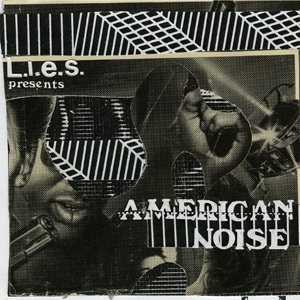Various Artists American Noise
Few labels have been more representative of New York in the past few years than […]

Few labels have been more representative of New York in the past few years than L.I.E.S. (a.k.a. Long Island Electrical Systems). Starting in 2010, its large discography of limited-edition 12″ releases established an underground reputation built on a raw approach to the dancefloor. Scarce in stores and difficult to source on the internet, it has quickly become a cult favorite for DJs and listeners interested in hardware-fueled abrasiveness. That said, the sheer volume of tracks coupled with a lack of availability has meant that the label has been somewhat inaccessible for casual listeners. American Noise, the imprint’s first compilation, rectifies that situation by providing an easy, two-disc entry point that contains one disc of previously released out-of-print favorites and a second of all-new material.
The first disc goes into the archives and pulls out 11 tracks that are mostly highly regarded b-sides and album cuts from records that now fetch high prices on the second-hand market. More than just a greatest hits, it also manages to get across the breadth of the label. Jahiliyya Fields’ “Servant Garden” and Steve Moore’s Frigia” begin the compilation by invoking a somber and spaced-out mood that plays to the ambient side of the label’s output. This atmospheric thread is a dominant aspect of the overall sound, with bare arrangements given a sense of depth by murky tape degradation.
Yet it’s in the fusion of ambiance and dancefloor appeal that the L.I.E.S. approach really shines. An example of this is Maxmillion Dunbar’s “Cassette Arabic,” which fuses sounds and voices evocative of the Middle East with a contorting TB-303 bassline. Its weird atmosphere and less-opaque background noise make it a perfect track out of leftfield—it sounds like it belongs on some long-lost DJ remix service EP from the 1980s. Similarly club approved is Two Dogs in a House’s “5th Floor,” the popular b-side of its Dog House EP. It’s a freaky immersion with a menacing bassline that pushes through warping percussion and strange melodies.
Maybe the most dance-inducing track on the first disc is Svengalisghost’s “Deep Into Memory.” Just as noisy as everything else, it’s a bouncing ride aboard jacking house rhythms and an acid bassline that continually threatens to spill over. What makes this track is the way in which everything seems to move with its own internal logic. Sounds and patterns come in and out of the background abruptly, without regard for standard bars, as though someone is working an MPC’s track mutes.
The second disc offers up 12 previously unreleased tracks that manage to maintain the standard of quality established by the first disc. In fact, it mostly surpasses it in style, as the 12 tracks feel closer to where L.I.E.S. is residing in 2012. Torn Hawk’s “This is Crime & Lace” starts up in an insane place, with blasts of noise riding over a chugging house rhythm married to occasional glimpses of guitar. It’s obviously sample based, but the loop plays like it was roughly chopped and thrown together, giving it an appealing dimension that’s lacking in more conventional edits. This style of bizarre editing plays a role throughout both discs, but finds its apex on “Journey,” a song by an uncredited artist. It’s a re-edit of some cosmic Afro track with synthesizer flourishes and tribal drumming made strange by psychedelic delay and mastering job that sounds like its been pushed down to a tenth-generation cassette tape.
Weirdness abounds. Bonquiqui’s “Sansoftime” stops mid beat, Professor Genius’ “Alamut” sounds like the soundtrack to an ’80s horror film, and Beau Wanzer’s “Jail Lock” could almost pass for the work of Throbbing Gristle. Yet it’s L.I.E.S. newcomer Delroy Edwards who provides the highlights of the second disc. First it’s “Feelings,” a gritty house song in the vein of Hieroglyphic Being that wheezes metallically over a mess of hi-hats and sci-fi noises. As abrasive as anything on the release, its more conventional sense of structure gives it a dancefloor appeal in spite of its harshness. His remix of Xosar’s “Tropical Cruize” is less abrasive, but just as good. It takes on ’90s house revivalism by appropriating the rhythm and symbolism of the past, while contorting it into something new. Xosar’s characteristically muffled singing is used here in a way that both parodies and mimics those faceless house divas of the past. And maybe that’s a good way of thinking about the label as a whole. While still using the palette—and even equipment—of the past, it’s somehow managed to move beyond pure revivalism and break into something entirely contemporary. It’s this aesthetic that’s conveyed so fully on American Noise, and that’s why it’s an essential release of 2012.

